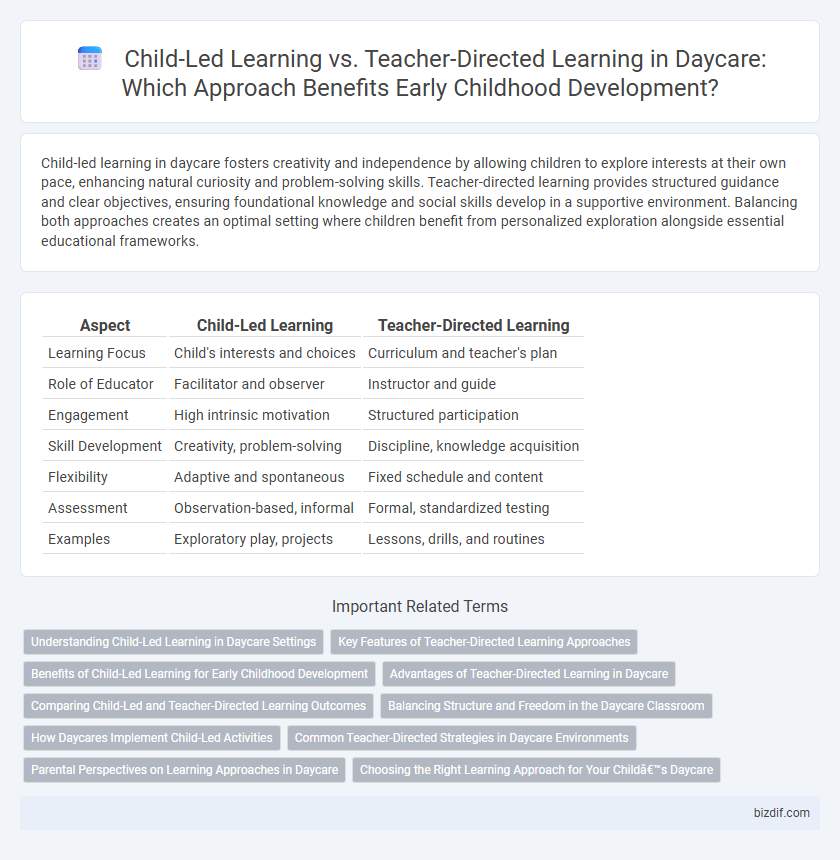Child-led learning in daycare fosters creativity and independence by allowing children to explore interests at their own pace, enhancing natural curiosity and problem-solving skills. Teacher-directed learning provides structured guidance and clear objectives, ensuring foundational knowledge and social skills develop in a supportive environment. Balancing both approaches creates an optimal setting where children benefit from personalized exploration alongside essential educational frameworks.
Table of Comparison
| Aspect | Child-Led Learning | Teacher-Directed Learning |
|---|---|---|
| Learning Focus | Child's interests and choices | Curriculum and teacher's plan |
| Role of Educator | Facilitator and observer | Instructor and guide |
| Engagement | High intrinsic motivation | Structured participation |
| Skill Development | Creativity, problem-solving | Discipline, knowledge acquisition |
| Flexibility | Adaptive and spontaneous | Fixed schedule and content |
| Assessment | Observation-based, informal | Formal, standardized testing |
| Examples | Exploratory play, projects | Lessons, drills, and routines |
Understanding Child-Led Learning in Daycare Settings
Child-led learning in daycare settings emphasizes fostering curiosity and independence by allowing children to guide their own activities and explore interests at their own pace. This approach supports social, emotional, and cognitive development by promoting creativity, problem-solving skills, and intrinsic motivation. Teachers observe and facilitate rather than direct, creating a flexible environment that responds to each child's unique learning needs and developmental stage.
Key Features of Teacher-Directed Learning Approaches
Teacher-directed learning in daycare centers emphasizes structured activities with clear objectives set by educators, fostering discipline and skill acquisition. This approach involves systematic instruction, continuous assessment, and guided practice to ensure mastery of foundational concepts. It prioritizes curriculum alignment, measurable outcomes, and consistency in teaching methods to support children's cognitive and social development.
Benefits of Child-Led Learning for Early Childhood Development
Child-led learning in daycare enhances early childhood development by fostering creativity, independence, and critical thinking skills, as children explore interests at their own pace. This approach supports social and emotional growth by encouraging peer interaction and self-regulation, leading to higher engagement and motivation. Research shows that child-led learning promotes language development and cognitive flexibility, essential for lifelong learning and problem-solving.
Advantages of Teacher-Directed Learning in Daycare
Teacher-directed learning in daycare provides structured guidance that ensures consistency in educational outcomes and helps develop foundational skills such as literacy and numeracy. It allows educators to tailor lessons to meet developmental milestones and address individual learning needs effectively. This approach also facilitates classroom management, promoting a safe and organized environment conducive to focused learning.
Comparing Child-Led and Teacher-Directed Learning Outcomes
Child-led learning fosters creativity, independence, and problem-solving skills by allowing children to explore their interests at their own pace, resulting in enhanced emotional and social development. Teacher-directed learning emphasizes structured guidance and clear objectives, often leading to improved academic performance and mastery of foundational skills. Comparing both, child-led approaches excel in nurturing intrinsic motivation and adaptability, while teacher-directed methods provide consistency and measurable progress in core competencies.
Balancing Structure and Freedom in the Daycare Classroom
Balancing structure and freedom in the daycare classroom enhances child development by integrating child-led learning with teacher-directed activities. Child-led learning fosters creativity, autonomy, and problem-solving skills as children explore their interests independently. Teacher-directed learning provides essential guidance and routine, ensuring a safe environment and foundational skill-building critical for early childhood education.
How Daycares Implement Child-Led Activities
Daycares implement child-led activities by creating flexible, interest-based learning environments that encourage exploration and creativity, allowing children to guide their own educational experiences. Educators observe and support rather than direct, fostering autonomy and critical thinking skills through hands-on play, open-ended questions, and choice-driven projects. This approach aligns with developmental theories emphasizing active engagement and intrinsic motivation, promoting holistic growth and social-emotional development in early childhood settings.
Common Teacher-Directed Strategies in Daycare Environments
Common teacher-directed strategies in daycare environments include structured activities like circle time, guided play, and direct instruction to promote skill development and routine establishment. These methods emphasize adult-led guidance where teachers set clear expectations, provide specific instructions, and model behaviors for social and cognitive growth. Consistent use of teacher-directed approaches supports early literacy, numeracy, and classroom management, ensuring children build foundational skills in a controlled setting.
Parental Perspectives on Learning Approaches in Daycare
Parental perspectives on learning approaches in daycare often highlight a preference for child-led learning due to its emphasis on fostering creativity, independence, and emotional development in children. Many parents value teacher-directed learning for its structured environment, promoting essential academic skills and social discipline. Balancing these approaches depends on individual family values, with research indicating that integrated models tend to support holistic child development and positive parental satisfaction.
Choosing the Right Learning Approach for Your Child’s Daycare
Choosing the right learning approach for your child's daycare involves understanding the benefits of child-led learning and teacher-directed learning. Child-led learning fosters creativity, independence, and engagement by allowing children to explore interests at their own pace, while teacher-directed learning provides structure, clear goals, and skill development through guided activities. Assessing your child's personality, developmental needs, and learning preferences helps determine the balance between these approaches to support optimal growth and socialization in daycare settings.
Child-led learning vs Teacher-directed learning Infographic

 bizdif.com
bizdif.com